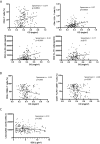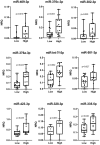Influence of air pollutants on circulating inflammatory cells and microRNA expression in acute myocardial infarction
- PMID: 35354890
- PMCID: PMC8967857
- DOI: 10.1038/s41598-022-09383-7
Influence of air pollutants on circulating inflammatory cells and microRNA expression in acute myocardial infarction
Abstract
Air pollutants increase the risk and mortality of myocardial infarction (MI). The aim of this study was to assess the inflammatory changes in circulating immune cells and microRNAs in MIs related to short-term exposure to air pollutants. We studied 192 patients with acute coronary syndromes and 57 controls with stable angina. For each patient, air pollution exposure in the 24-h before admission, was collected. All patients underwent systematic circulating inflammatory cell analyses. According to PM2.5 exposure, 31 patients were selected for microRNA analyses. STEMI patients exposed to PM2.5 showed a reduction of CD4+ regulatory T cells. Furthermore, in STEMI patients the exposure to PM2.5 was associated with an increase of miR-146a-5p and miR-423-3p. In STEMI and NSTEMI patients PM2.5 exposure was associated with an increase of miR-let-7f-5p. STEMI related to PM2.5 short-term exposure is associated with changes involving regulatory T cells, miR-146a-5p and miR-423-3p.
© 2022. The Author(s).
Conflict of interest statement
The authors declare no competing interests.
Figures






References
-
- Von Klot S, Peters A, Aalto P, Bellander T, Berglind N, D’Ippoliti D, et al. Ambient air pollution is associated with increased risk of hospital cardiac readmissions of myocardial infarction survivors in five European cities. Circulation. 2005;112(20):3073–3083. doi: 10.1161/CIRCULATIONAHA.105.548743. - DOI - PubMed
-
- Bañeras J, Ferreira-González I, Marsal JR, Barrabés JA, Ribera A, Lidón RM, et al. Short-term exposure to air pollutants increases the risk of ST elevation myocardial infarction and of infarct-related ventricular arrhythmias and mortality. Int. J. Cardiol. 2018;250:35–42. doi: 10.1016/j.ijcard.2017.10.004. - DOI - PubMed
Publication types
MeSH terms
Substances
LinkOut - more resources
Full Text Sources
Other Literature Sources
Medical
Research Materials

